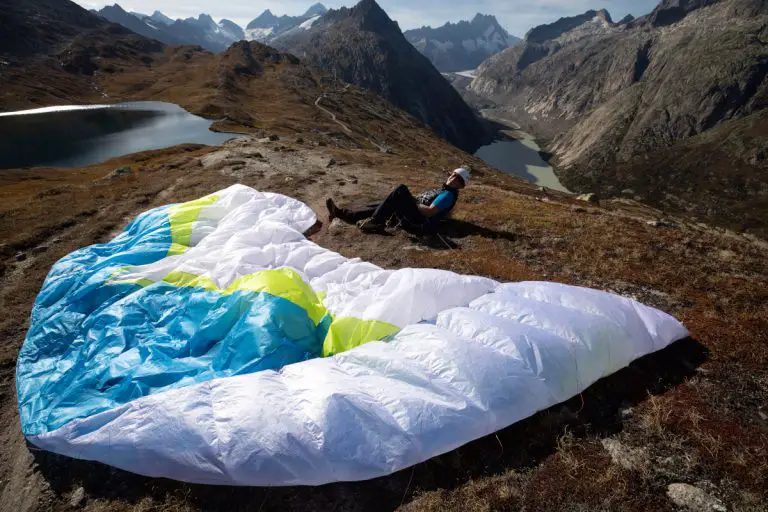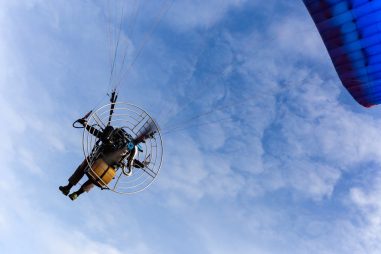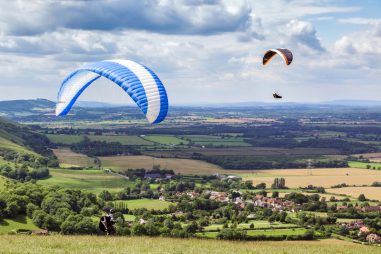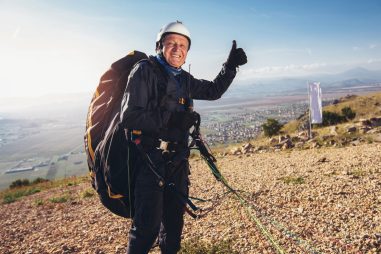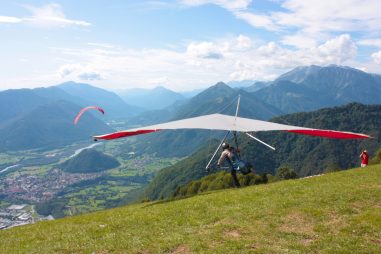The way you care for your paraglider can make a huge difference in its life span. A few ways you can maintain the quality of your paraglider are by cleaning it thoroughly, folding it without bending the internal reinforcements, storing it in a dry place, and transporting it correctly.
How Do I Prepare for Paragliding?
Preparation is crucial in paragliding. A well-prepared pilot has the skill and the knowledge required for flying and has the right well-maintained equipment. Here are fundamental tips that can help you prepare before taking your first flight solo.
Tips for well-prepared paragliding:
- Do tandem paragliding: This sport will require time and effort and is costly. Before you decide whether to be serious about this sport, it is recommended you do tandem paragliding first. It will help gauge how comfortable you are gliding in the air and get you to experience the flight firsthand with a professional.
- Enroll in a paragliding school: The best way to learn paragliding is to enroll in a course. You will learn about different weather conditions, safety tips, and how to maneuver your glider.
- Join a paragliding club: You can choose any club close to your home or the one your paragliding school has. Joining would mean you can find fellow pilots you can fly with. You can also receive advice from them directly, whether on a flying technique or a good paragliding location.
- Buy the best paragliding kit for you: You can rent the equipment from your school or buy one for yourself. As a novice, you will need a paraglider, harness, a reserve parachute, a helmet, and a variometer. Seek advice from your instructor to get the right equipment suited for you. Experienced pilots do not recommend a secondhand paragliding kit, as you won’t know if there are defects.
- Check your equipment: Know the condition of your equipment. Do a thorough inspection before and after you fly to ensure you are safe while in the air. Have a checklist with you. Remember, your safety is always the priority.
- Never fly alone: Not only is it more fun to fly with friends and family, but it also adds a safety precaution in case of emergency.
- Check the weather: Having a solid knowledge of the weather is necessary when paragliding. Not all weather conditions are fit for flying, and some are even dangerous. Your skill and knowledge will be your best asset, particularly when the weather changes while you’re in the air.
- Know the area well: As a beginner pilot, you will learn to start by foot launching. Being aware of any obstructions around you, like trees or huge rocks, would help you have a safe launch as the glider may be difficult to stop once the wind starts to lift you.
- Get a paragliding mentor: A successful paragliding pilot refines his skill with constant practice and study. Finding a mentor would contribute to your training and help you with techniques to use while flying. Doing this will help with your progress and, of course, will keep you safe.
In paragliding, and like every sport, commitment to preparation is equal to safety. A great pilot reduces the risk of accidents by observing the rules.
How Do You Put a Paragliding Harness On?
A well-adjusted harness should allow you to lift your legs and slide into a comfortable, secure position right after your takeoff. The setup of your paraglider harness is pivotal as you don’t want to be in the air and find out the fitting doesn’t meet your comfort preferences. While on the ground, spend time adjusting the harness to your body.
Steps to putting on and adjusting a paragliding harness:
- Remove the straps and sit on the harness.
- Put the shoulder straps. Adjust the straps so that the edge of the seat board doesn’t hit your legs when you run during takeoff.
- Put the chest strap on. Adjust the strap perfectly enough that it isn’t too unstable or too tight for you to move. The chest strap is usually 40 to 48cm (15 to 19 inches) for certification flights.
- Adjust your backrest. An upright position will allow you to observe your surroundings better. A more backward tilt, on the other hand, is substantial for aerodynamics. Get a good compromise between the two.
- If your harness has a strap between the carabiners and the seat board, adjust it longer for a more stable harness. A steady harness is helpful for windy situations.
- Check if your seat board has a strap for adjustment. Adjust the seat board high if you prefer leaning backward with your knees up. Otherwise, if you want your knees to be low, you can lower your seat board to let your body lean forward.
- Adjust the footrest sufficiently so that you can extend your legs without force, or else it will lead to fatigue.
If you are having a hard time getting into your harness and making adjustments, there are a few factors to consider. It may be that the size, technique, or setup is wrong. It is always best to be with a professional when adjusting your harness for the first time to get the utmost comfort and support while flying.
How to Trim Paraglider Lines
Trimming your paraglider lines is necessary to help optimize your glider’s performance. It also helps the pilot handle turbulence better, giving you more stability and collapse recovery. When trimming your paraglider lines, it is best to go to a professional who can measure each of your glider’s lines to see their strength and durability.
To check paraglider trim:
- You will need a laser measure to examine the length of each line.
- Excel for interpreting measurements.
- A tensioning system perfect for accuracy when measuring.
The professional will interpret the data based on the measurements. Doing this will allow you to best maximize the performance of your paraglider. They will also test your paraglider after trimming to see if any other adjustments are needed.
How Do You Clean a Paraglider?
Cleaning your paraglider is one way you can make it last longer. When cleaning, avoid using a stiff brush or harsh chemical soap. Soft cloth and clean water is always the way to go, then drying it out in a shaded area. Here are a few more tips you can do to make sure your canopy is always at its best.
Tips to look after your paraglider:
- Clean your paraglider regularly: Check for dust, insects, grass, or any particles. It is recommended that you do so after flying to avoid moisture or dirt buildup.
- Use fresh water: As mentioned before, any chemical can harshly affect the durability of your paraglider wing.
- Don’t scrub too hard: Instead, be gentle when cleaning your canopy. It will prevent any visible damage and won’t affect its wear. Opt for a light sponge or a soft cloth when scrubbing.
- Dry your wing thoroughly before storing: Avoid storing your paraglider while wet. It may promote moisture buildup, which will then affect the delicate surface of your canopy.
- Dry your wing on a shaded area: There isn’t much you can do about sunlight, but your paraglider wings are sensitive to sunlight wear. Therefore, when drying your canopy, do so in a shaded area to avoid further sun exposure.
Paragliders wear and break over time due to mechanical and environmental reasons. Their durability also depends on how well you care for them overall. The better maintained a paraglider is, the longer it will last with you.
How Do You Get Sand Out of a Paraglider?
You may notice after your flight that there is sand on your paraglider wing. It is common when paragliding on the beach. Sand either gets inside or sticks to your paraglider because of static electricity, making it hard to remove. Clearing them out can be a bit tricky, but there are different methods you can use.
- Shake it up: Lay your canopy on a patch of grass. Do this with a friend to help shake up the wing with the nose pointing to the ground. It can be hard to take all the sand out at the tips of the canopy but shake it so the sand can get into the boat hull, where you can take the sand out manually.
- Use metal: Hang your paraglider wing and use metal with no sharp edges to discharge the static electricity. Do this by sliding off the metal around the canopy, ensuring there aren’t sharp edges.
Getting sand on your paraglider is normal and is part of the experience as you paraglide to different locations. As long as you get most of the sand out, it should not affect the durability of your wings.
How Do You Dry a Paraglider?
When your paraglider gets wet, let it dry out in a shady place, away from direct heat exposure, sharp objects, or insects. Thoroughly drying your paraglider will remove the risk of moisture buildup. Not preventing this will affect the surface and performance of your glider wing.
Tips when your paraglider gets wet:
- Wash out saltwater: If your paraglider wings come in contact with salt water, take them out immediately and rinse them with fresh water. Saltwater can erode nylon and lessen its longevity.
- Pull carefully: Pull your canopy off the water carefully by the trailing edge.
- Dry it out: Dry your paraglider wing in a shaded area between thirty minutes to one hour.
- Dry some more: After drying them for about an hour, you can also choose to fly them out to help the paraglider lines utterly dry.
- Mind where you place it: When drying them on the ground, leave them on a clean surface, or a patch of grass, away from sharp objects.
Remember to dry your paraglider thoroughly. It will prevent moisture and dirt buildup and will keep your canopy well-maintained.
How Do You Fold a Paraglider Wing?
How you fold your paraglider wing will directly affect its longevity and performance. You want to avoid bending the plastics inside the glider or causing abrasions on the surface of the wing. There are different methods to fold a paraglider wing based on your preference. Below is a technique called the Compression Packing Method.
Folding using the compression method:
- Get the center of your wing and lay it out nicely.
- Clip your brakes, and leave one meter of line on the trailing edge. Keep the lines on top of the glider.
- Do an S fold along the trailing edge towards the center, do this on both sides, folding it up to four cells.
- Compress the glider to get the air out towards the leading edge.
- Bring your harness forward, putting it on top of the folded glider.
- Go around the front and pull on the cells to get tension.
- Gather the nose cones on both sides and do the concertina folds. Push air out.
- Place your legs in between the wing and use your feet to trap the canopy. It will give a tensioned section at the front of the glider.
- Pull the folded nose cones and bend them to the left to fold. Tidy it up by taking the air out and folding the loose fabric inwards.
- The nose cones should be at the center. You can then lift the glider from the ground and put them in the bag.
- Fold the tail over the top of the bag, and compress the air out.
- Seal the bag and compress.
The compression packing method is one folding technique you can use when you don’t have a concertina bag. It keeps the leading edge protected and well compressed. This method works better for paraglider wings with short reinforcing rods.
How Do You Fold a Concertina Paraglider?
The concertina method is another folding technique and is the most efficient way to ensure the integrity of your wing. It preserves the performance and durability of your paraglider as you travel.
Folding using concertina packing method:
- Get your concertina bag out to prepare.
- Get the harness and put it on the base of the concertina bag.
- Lay your paraglider wing to the center of the concertina bag in a mushroomed position. Then, look for the middle cell, and put the plastic reinforcements side by side.
- Find the strap and secure it.
- Loosely bring the trailing edge on top of each other towards the center.
- Make sure that the lines are inside the glider.
- Start to zip up from the trailing edge. Push the material done as you zip up to avoid damaging the wing.
- Fold the concertina bag three to four times from top to bottom. Do it from bottom to top if your rods are longer.
- Strap the bag and put it in your harness.
If you prefer the concertina packing method, invest in a good concertina bag. The bag will help maintain the shape of the leading edge as there is only minimal panel stretching and abrasion.
How to Pack Away a Paraglider
Negligent packing of your paraglider wing can damage the plastic reinforcements of the canopy. This will affect the overall performance of your glider. Be wary of how long or short your rods are, and carefully fold them to prevent the internal reinforcements from breaking. A well-packed paraglider is a well-maintained one!
Tips in packing a paraglider:
- Avoid rough surfaces: Avoid dragging the wing on the ground as it may cause abrasion and damage the surface of the canopy.
- Press down gently: Pressing too hard on the wing causes stress to the seams, especially when folded.
- Use different packing methods: Using the same packing technique may strain the same seams and plastic reinforcements. Try doing differing packing methods each time.
- Read the manual: Gliders have instructions with them that contain packing instructions, so your reinforcement rods are protected and not bent too much.
- Gather the lines together: The lines should be together and placed at the center of the canopy before folding to keep it safe.
- Dry it out: A damp canopy and lines will be damaged if packed without thoroughly drying it first.
- Keep it loose: Compress only to get the air out, but leave the fabric loosely to avoid pressure on the equipment.
There may be an instance where you need to pack your paraglider quickly and cannot follow the guidelines above. In this case, unpack and correct your folding as soon as you’re able.
How Do You Store a Paraglider?
Eventually, you will need to store your paraglider. Unfortunately, your paraglider’s biggest enemy is high humidity. A buildup in moisture can deteriorate the quality of the canopy and the lines. Therefore, keeping your glider in the correct place is crucial to maintain its life longer.
Tips to safely store your paraglider:
- Keep it dry: A damp canopy or line invites moisture buildup. Ensure your glider is completely dry before storage.
- Clean your paraglider: Be wary of dirt, dead insects, or grass stuck on your glider. Instead, use a soft cloth and wipe it gently off your glider.
- Avoid heat, chemicals, sharp objects, and insects: Temperature affects fabric. Stow your glider away from direct sun exposure or different weather conditions. Store it away from sharp objects or areas where insects could come in.
- Keep your paraglider bag clean: Maintain a clean paraglider bag to avoid dirt transferring to your glider.
- Avoid folding in the same places: Instead, use different folding methods to release pressure in the same areas.
- Don’t leave your paraglider on the ground: The surface may be abrasive and, therefore, can damage your canopy.
Invest in a dehumidifier or use AC to keep the temperature of the storage room conditioned well. Follow additional storage tips provided by your glider’s manufacturer to keep your equipment in top condition.
How Do You Transport a Paraglider?
There are different ways to transport a paraglider. Transporting is quite common in this sport as pilots go around the world to fly in various paragliding-approved locations. Here are some ways you can transport your equipment:
- Use a shipping service specifically for transporting a paraglider: Some companies do this and provide various options depending on how fast you need it and where you are transporting your glider.
- Transport it via plane: Depending on how big your paraglider is, you can take it as a carry-on or additional luggage. It is also best to contact your airline to get information and to know if there are certain restrictions, especially per country.
- Store it in the concertina bag: Then, if you are traveling nearby, you can keep it in your paraglider bag and carry it with you without issues.
When traveling with your paraglider, ensure that it’s folded well and away from heavy objects. It will avoid creasing and reduce pressure on the internal reinforcements of your paraglider wing.
Can You Travel by Paragliding?
Yes, you can travel by paragliding. There are many accessible locations you can visit when paragliding, but you can’t paraglide everywhere. Also, there are certain restrictions that vary depending on the country. It’s best to be aware of them when paragliding to a different place for the first time.
Common restrictions in paragliding:
- No-fly zones: There are areas with no-fly zones, for example, military bases, private lands, or places restricted from public access.
- Flight paths: Although you can go as high as 18,000 feet (5,500 meters) above the ground, there is a restriction on high altitude in flight paths to avoid a plane collision.
- Age restriction: The age restriction for paragliding differs per country. For instance, the minimum age for a solo paraglider in the UK is 16 years old.
- Your paragliding level: You won’t be allowed to fly on an advanced paragliding location if you are on a beginner level. You will have to pass certification for them to permit you to paraglide in certain places.
It is recommended that you check the regulations in your area or the location you wish to visit for paragliding. They can differ substantially. Respect the rules where paragliding is off-limits to avoid imposing risk to yourself and others.
How Do You Travel With a Paraglider?
You can travel with a paraglider using a concertina bag that will keep your canopy safe and secured. When traveling on a plane, call the airline ahead of time to see if any extra baggage fee is required. You can also put your equipment in a laundry sack to keep the straps together.
You might worry if you leave your equipment checked in as you are never sure if they’ll handle your bag well. You can opt to put it in a suitcase where you can add blankets or clothes around to keep the glider from moving or hitting heavy objects.
A well-maintained paraglider will keep you safe while in the air. Now that you know everything to care for your paraglider, you are ready for your first flight. Have fun flying!

